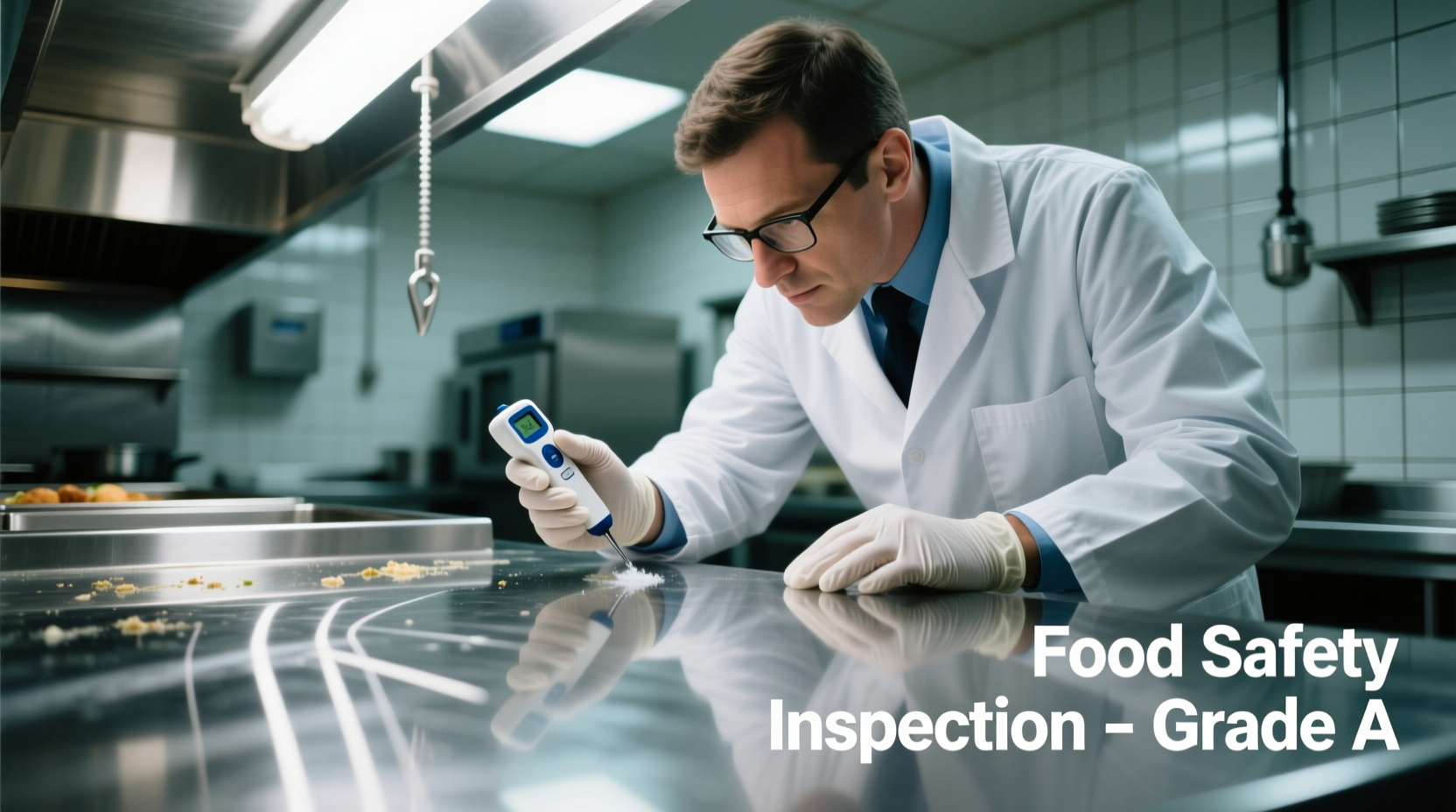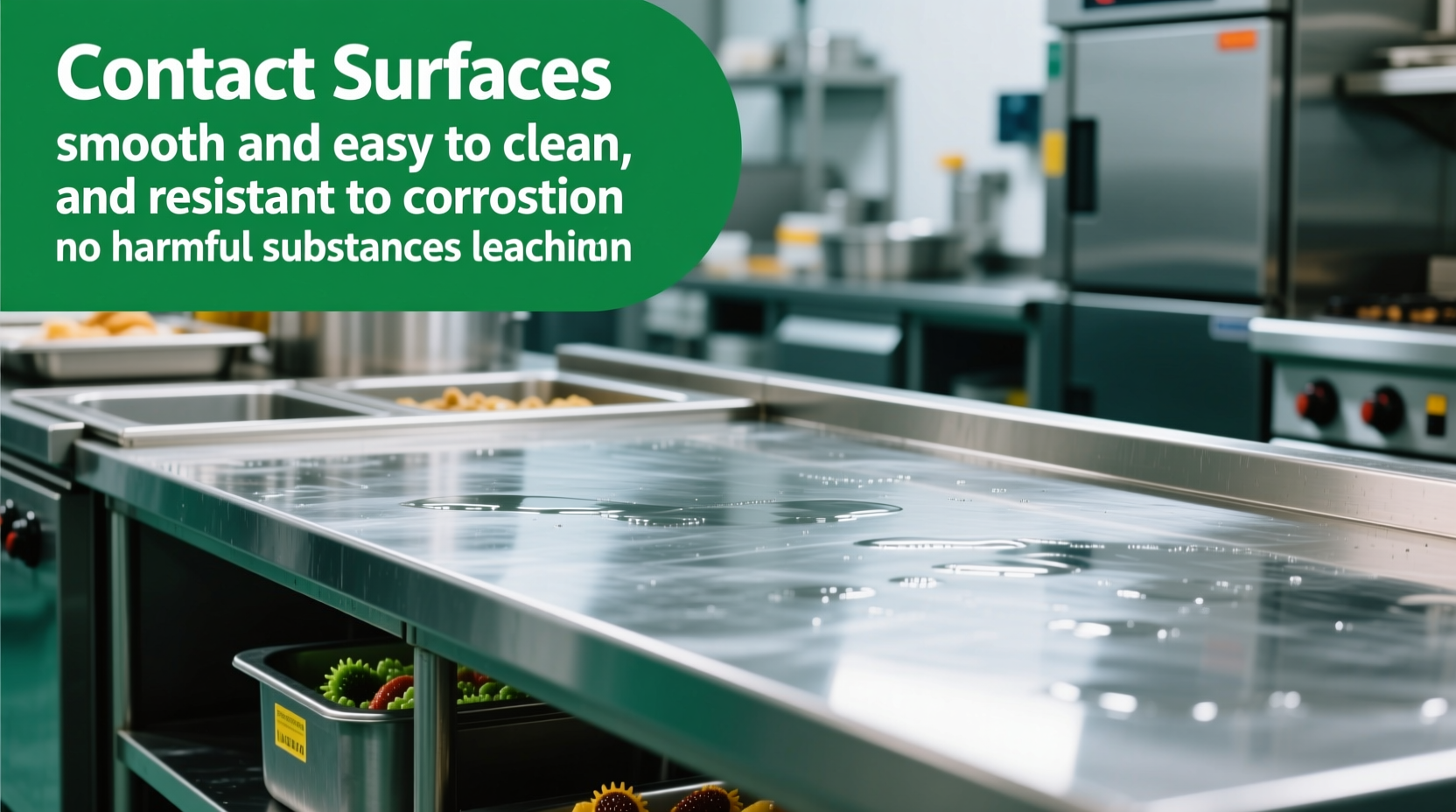The three essential characteristics that all food contact surfaces must have are: non-toxicity, smooth and non-absorbent properties, and corrosion resistance. These requirements ensure surfaces won't contaminate food, can be properly cleaned and sanitized, and maintain integrity in food preparation environments.
Understanding what makes food contact surfaces safe isn't just regulatory compliance—it's fundamental to preventing foodborne illness and protecting public health. Whether you're a restaurant owner, food manufacturer, or home cook, knowing these critical characteristics helps you make informed decisions about the equipment you use daily.
Why Food Contact Surface Characteristics Matter for Public Health
Food contact surfaces include any material that touches food during preparation, processing, storage, or service—from cutting boards and countertops to conveyor belts and packaging materials. According to the FDA Food Code 2022, these surfaces must maintain specific properties to prevent contamination that could make consumers sick.
When surfaces fail to meet these requirements, they become breeding grounds for pathogens like Salmonella, E. coli, and Listeria. The CDC estimates foodborne illnesses affect 48 million Americans annually, with improper food contact surfaces contributing to preventable outbreaks.

Characteristic #1: Non-Toxic Materials That Won't Leach Into Food
The first non-negotiable characteristic is that food contact surfaces must be made from non-toxic materials that won't transfer harmful substances to food. This requirement appears in FDA Food Code Section 4-101.11(A), which states surfaces must be "nontoxic" under normal use conditions.
Why this matters:
- Prevents chemical migration from surfaces to food
- Ensures materials won't degrade when exposed to food acids or cleaning chemicals
- Maintains food integrity without altering taste or safety
Common compliant materials include:
| Material Type | Common Applications | Key Advantages |
|---|---|---|
| Stainless steel (304 grade) | Countertops, sinks, equipment | Resists corrosion, durable, easy to clean |
| Food-grade plastics (HDPE, PP) | Cutting boards, containers | Lightweight, affordable, NSF-certified options |
| Glass | Prep surfaces, storage | Non-porous, doesn't absorb odors |
Materials to avoid include untreated wood (except for specific applications like butcher blocks with proper maintenance), porous ceramics, and metals like copper or zinc that can leach into acidic foods.
Characteristic #2: Smooth and Non-Absorbent Surface Texture
Food contact surfaces must have a smooth, non-absorbent texture that allows for effective cleaning and sanitation. The FDA Food Code specifies surfaces must be "easily cleanable" and "nonabsorbent" to prevent harboring pathogens.
Surface texture directly impacts cleanability:
- Rough surfaces create microscopic crevices where bacteria can hide
- Absorbent materials (like untreated wood) trap moisture and contaminants
- Scratches and dents become impossible to properly sanitize
Testing surface smoothness:
Food safety professionals often use a technique called "surface profilometry" to measure microscopic surface variations. For food contact surfaces, the acceptable roughness average (Ra) should be below 0.8 micrometers. In practical terms, your fingernail shouldn't catch on the surface, and no visible scratches should be present.
When evaluating surfaces:
- Run your finger across the surface—any texture should be imperceptible
- Check for visible scratches, chips, or cracks
- Ensure no moisture remains after wiping (indicates absorption)
Characteristic #3: Corrosion Resistance for Long-Term Safety
The third essential characteristic is corrosion resistance. Food environments expose surfaces to moisture, acids, salts, and cleaning chemicals that can degrade materials over time. Corrosion creates pits and rough areas that harbor bacteria and may introduce metal contaminants into food.
Why corrosion resistance matters:
- Prevents metal particles from contaminating food
- Maintains smooth surface integrity over time
- Ensures surfaces remain non-absorbent throughout their lifespan
Common corrosion challenges in food environments:
- Acidic foods (tomatoes, citrus) accelerating metal degradation
- Chlorine-based sanitizers causing pitting in improper stainless steel grades
- Salt exposure in seafood preparation areas
Material selection is critical—304 stainless steel works for most applications, but 316 grade (with molybdenum) is necessary in high-salt environments like seafood processing. For plastic surfaces, ensure they're specifically formulated to resist chemical degradation from frequent cleaning.
Practical Implementation: Evaluating Your Food Contact Surfaces
Knowing these characteristics is only valuable if you can apply them. Here's how to evaluate your current surfaces:
- Conduct a visual inspection—look for cracks, chips, discoloration, or pitting
- Perform the fingernail test—run your fingernail across surfaces; if you feel texture, it's not smooth enough
- Check for water beading—on properly non-absorbent surfaces, water should form beads rather than soaking in
- Review material specifications—ensure equipment meets NSF/ANSI Standard 2 for food equipment
Establish a regular inspection schedule based on usage frequency. High-traffic areas like commercial kitchen countertops may need weekly checks, while less frequently used equipment might require monthly evaluations.
Regulatory Context: Food Code Requirements
These three characteristics aren't arbitrary—they're codified in food safety regulations worldwide. The FDA Food Code 2022, which forms the basis for most U.S. health department regulations, specifies in Section 4-101.11:
"Food-contact surfaces of equipment and utensils shall be smooth, easy to clean, and maintain integrity. They shall be made of non-toxic materials that resist corrosion, chipping, and cracking under normal use conditions."
Local health inspectors routinely check for these characteristics during inspections. Failure to maintain proper food contact surfaces is among the top five critical violations cited during restaurant inspections according to the CDC's Environmental Health Specialists Network.
Maintenance Best Practices for Long-Term Compliance
Even surfaces that initially meet requirements can degrade over time. Follow these maintenance practices:
- Use appropriate cleaning methods—avoid abrasive pads on stainless steel
- Replace cutting boards when deep scratches appear
- Address rust spots immediately before they spread
- Follow manufacturer's cleaning recommendations for specialized surfaces
- Train staff on proper handling to prevent surface damage
Remember that proper maintenance extends the life of your equipment while ensuring ongoing food safety. Investing in quality surfaces pays dividends through reduced replacement costs and, more importantly, protection against food safety incidents.
Frequently Asked Questions
Can wood cutting boards be used as food contact surfaces?
Yes, but with important limitations. Hardwood cutting boards (like maple or walnut) can be used if properly maintained, but they must be regularly cleaned, sanitized, and replaced when deep scratches appear. Softwoods and end-grain boards require more careful maintenance. Many health departments prohibit wood cutting boards in commercial settings due to absorption risks, while allowing them in home kitchens with proper care.
How often should food contact surfaces be replaced?
Replacement frequency depends on material and usage. Stainless steel surfaces may last decades with proper care, while plastic cutting boards typically need replacement every 1-2 years in commercial settings or when visible scratches appear. Regular inspections should identify when surfaces no longer maintain smooth, non-absorbent properties. Any surface with cracks, deep scratches, or corrosion should be replaced immediately.
Are there exceptions to these requirements for specific food types?
Some specialized applications have specific requirements. For example, traditional cheese aging might use wooden surfaces under controlled conditions, and certain fermentation processes use specific container materials. However, these exceptions require documented food safety plans and often special regulatory approval. The three fundamental characteristics still apply, though implementation may vary based on scientific justification.
What's the difference between food-grade and food-safe materials?
Food-grade materials are certified safe for food contact but may not be durable enough for repeated cleaning. Food-safe materials meet both safety and durability requirements—they won't leach chemicals AND maintain their integrity through regular cleaning and sanitizing. All food contact surfaces must be food-safe, not just food-grade, to meet regulatory requirements.











 浙公网安备
33010002000092号
浙公网安备
33010002000092号 浙B2-20120091-4
浙B2-20120091-4